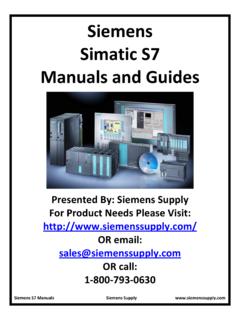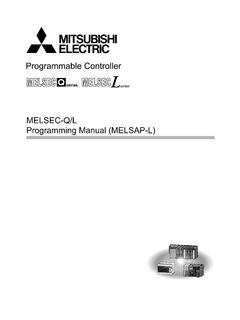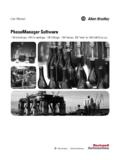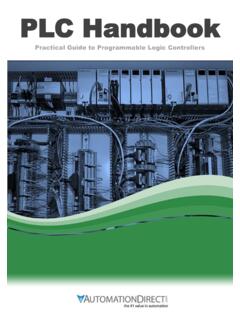Transcription of Siemens Simatic S7 Manuals and Guides
1 Siemens Simatic S7. Manuals and Guides Presented By: Siemens Supply For Product Needs Please Visit: OR email: OR call: 1-800-793-0630. Siemens S7 Manuals Siemens Supply Table of Contents m Number co 2. 1. Basic 8. 1. y. S7-200 Micro Programming a pl Discrete 1. Analog Inputs and up 1. ss High-Speed 1. Specialized Expansion en Review Final 74. m ie .s w w w . Introduction Welcome to another course in the STEP series, Siemens Technical Education Program, designed to prepare our m distributors to sell Siemens Industry, Inc. products more effectively. This course covers Basics of PLCs and related co products. Upon completion of Basics of PLCs you should be able to: y. Identify the major components of a PLC and describe their functions pl Convert numbers from decimal to binary, BCD, and hexadecimal.
2 Up Identify typical discrete and analog inputs and outputs Identify key differences of the various S7-200 models Identify the types of expansion modules available for ss S7 200 PLCs . Describe the types or programming available for S7-200. en PLCs Describe the operation of commonly used program functions such as timers and counters . m Identify the proper manual to refer to for programming or installation of an S7-200 PLC. ie This knowledge will help you better understand customer applications. In addition, you will be better able to describe .s products to customers and determine important differences between products. You should complete Basics of Electricity before attempting Basics of PLCs. An understanding of many w of the concepts covered in Basics of Electricity is required for this course.
3 W After you have completed this course, if you wish to determine w how well you have retained the information covered, you can complete a final exam online as described later in this course. If you pass the exam, you will be given the opportunity to print a certificate of completion.. Siemens is a trademark of Siemens AG. Product names mentioned may be trademarks or registered trademarks of their respective companies. Specifications subject to change without notice. m co y. pl up ss en m ie .s w w w . PLCs A programmable logic controller (PLC), also referred to as a programmable controller , is the name given to a type of m computer commonly used in commercial and industrial control applications. PLCs differ from office computers in the types of co tasks that they perform and the hardware and software they require to perform these tasks.
4 While the specific applications vary widely, all PLCs monitor inputs and other variable values, y. make decisions based on a stored program, and control outputs to automate a process or machine. This course is meant to supply you with basic information on the functions pl and configurations of PLCs with emphasis on the S7-200 PLC. family. up Motor ss Indicator Light en SF/DIAG. Pump m ie Sensor Pushbutton .s Basic PLC Operation The basic elements of a PLC include input modules or points, a central processing unit (CPU), output modules or points, w and a programming device. The type of input modules or points used by a PLC depends upon the types of input devices w used. Some input modules or points respond to digital inputs, also called discrete inputs, which are either on or off.
5 Other w modules or inputs respond to analog signals. These analog signals represent machine or process conditions as a range of voltage or current values. The primary function of a PLC's input circuitry is to convert the signals provided by these various switches and sensors into logic signals that can be used by the CPU.. The CPU evaluates the status of inputs, outputs, and other variables as it executes a stored program. The CPU then sends signals to update the status of outputs. Output modules convert control signals from the CPU into digital or analog values that can be used to control various output devices. The programming device is used to enter or change the PLC's m program or to monitor or change stored values. Once entered, the program and associated variables are stored in the CPU.
6 Co In addition to these basic elements, a PLC system may also incorporate an operator interface device to simplify monitoring of the machine or process. y. pl Input Central Processing Unit Output Module (CPU) Module up ss Programming Operator Device Interface en In the simple example shown below, pushbuttons (sensors). connected to PLC inputs are used to start and stop a motor m connected to a PLC output through a motor starter (actuator). No programming device or operator interface are shown in this simple example. ie Motor Motor Starter .s w w Output w SF/DIAG. PLC. Inputs Start Stop Pushbutton Pushbutton . Hard-Wired Control Prior to PLCs, many control tasks were performed by contactors, control relays, and other electromechanical devices.
7 This is often referred to as hard-wired control. Circuit diagrams had to be designed, electrical components specified and installed, and wiring lists created. Electricians would then wire the components necessary to perform a specific task. If an error was made, the wires had to be reconnected correctly. A change in function or system expansion required extensive component changes and rewiring. m co M OL T1. L1. M OL T2. 460 VAC L2 Motor M OL T3. L3. y. OL. 1 M. CR. pl 24 VAC. Start Stop 2 CR. up CR. ss Advantages of PLCs PLCs not only are capable of performing the same tasks as hard-wired control, but are also capable of many more complex applications. In addition, the PLC program and electronic en communication lines replace much of the interconnecting wires required by hard-wired control.
8 Therefore, hard-wiring, though still required to connect field devices, is less intensive. This also makes correcting errors and modifying the application easier. m Some of the additional advantages of PLCs are as follows: ie Smaller physical size than hard-wire solutions..s Easier and faster to make changes. PLCs have integrated diagnostics and override functions. w Diagnostics are centrally available. Applications can be immediately documented. w Applications can be duplicated faster and less expensively. w Siemens Modular PLCs Siemens Simatic PLCs are the foundation upon which our Totally Integrated Automation (TIA) concept is based. Because the needs of end users and machine builders vary widely, Simatic PLCs are available as conventional modular controllers, embedded automation products, or as PC-based controllers.
9 Modular Simatic controllers are optimized for control tasks and can be adapted to meet application requirements using plug-in modules for input/output (I/O), special functions, and communications. Examples of products in this category include: LOGO!, S7-200, and S7- 200 micro automation products, 1. S7-300 and S7-400 modular system PLCs, C7 combination controller and panel, and ET 200 distributed I/O system with local intelligence. m Simatic . S7-1200. SF/DIAG. co Simatic S7-200 Simatic S7-1200 LOGO! y. pl Simatic S7-400. up Simatic S7-300. ss Other Simatic Controllers Simatic embedded automation products are available in a microbox, panel PC, or multi-functional PC-based system. All products utilize rugged, fan-free, diskless hardware en platforms with an operating system optimized for each platform.
10 Examples of products in this category include: Microbox 420 RTX, Microbox 420-T, Panel PC 477-HMI/RTX, and . WinAC MP. m Simatic PC-based controllers are available as software that ie can run on standard PC systems or in a plug-in card (slot PLC). for increased reliability. This category includes WinAC software .s and WinAC slot PLC. Simatic Software Simatic software is the universal configuring and w programming environment for Simatic controllers, human machine interface systems, and process control systems. w Simatic software with STEP 7 and numerous engineering tools supports all phases of product deployment, from w hardware configuration of the system and parameterization of modules to service of the installed system.




![FXCPU Structured Programming Manual [Device & Common]](/cache/preview/9/4/7/8/3/8/3/1/thumb-94783831776d09386da6cbb173745dcd.jpg)
